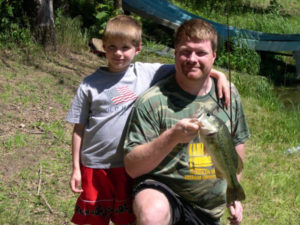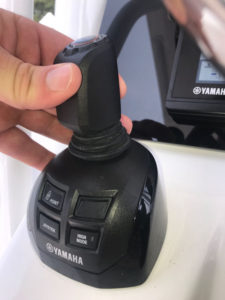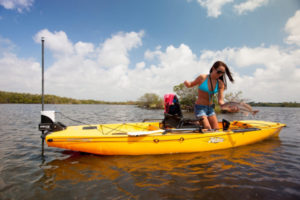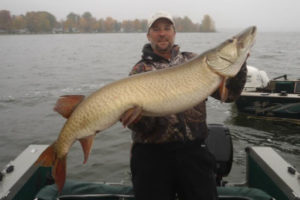Big Laser WMA Profile
Georgia’s public hunting areas include a mixture of National and State land, including Wildlife Management Areas, Natural Areas, National Forest and State Parks open for hunting. The choices are scattered all over the state and include a wide variety of habitat and hunting opportunities.
So how do you choose one if you are looking for a place to hunt on public land?
A little over two years ago Randy White started planning his move to Georgia from Virginia where he had lived and hunted for many years. While looking for a house, he discovered Georgia Outdoor News and started subscribing. He studied the Public Hunting Area information and chose three areas that met his requirement, and applied for quota hunts on them for the 2003 season.
The three areas he applied for were Big Laser, West Point and B.F. Grant. They were chosen based on being Quality Deer Management areas, having relative high hunter success rates and producing big bucks each year. He was drawn for a gun hunt on Big Laser where he killed a 10 point buck that scored 116 4/8 points on November 12th. On a muzzleloader hunt on West Point he got an 8 point buck.
Randy chose a good area at Big Laser for several reasons. The area is 9 square miles – 5900 acres – of land on the Flint River south of Thomaston. The river valley in that area is steep with high hills dropping to the river, so there is not much river bottom. But there are a lot of hardwood ridges, rolling hills, pine woods and thickets.
Stacey Koonce killed a 14 point buck at Big Laser that scored 102 1/8 points after having a 17 point deduct for sticker points and a spade brow tine. It was killed two days after Randy got his big buck, and Stacey says the buck was hard on a doe. When it walked up on him its tongue was hanging out and he was ignoring everything else.
The fact those two big deer were both killed in mid-November should give you an idea of the best time to hunt Big Laser. Although all the hunts can be good, the mid-November hunt is going to be during the height of the rut.
Stacey killed his deer at about 11:00 AM, close to the same time Randy killed his, and after many hunters have left their stands. That is another factor to keep in mind, stay in your stand as late as you can stand it, then wait longer. Many big deer are killed in the middle of the day on public hunting areas.
Lee Kennemer is the wildlife biologist in charge of Big Laser. He says Big Laser is a beautiful area to hunt with big hardwood groves on ridges around the river and on the hills away from the river. These open oak woods look like perfect deer habitat, and they do produce acorns for the deer in the fall. It is pretty, but it does not produce food for deer year round.
There is a lot of other kinds of habitat that produces food for the deer. The deer are healthy there even though the body weight is down a little due to the drought conditions the past few years. Antler growth has held up, though.
There are 30 permanent food plots on the area that cover 110 acres. Due to budget restrictions, not many new food plots are being put in, and the current ones are being managed for long term food production with Bahia grass and some overseeding of wheat. A few also contain some clover. Most are winter and summer plots with few fall food plots in production.
Although there are not many changes for the past couple of years, DNR personnel are working to keep older food plots from becoming shaded in and expanding existing plots when money is available. The wheat that is overseeded is the major effort for the fall, and the plots with clover in them also produce food in the fall. Last year there were about 30 acres planted in wheat for the fall.
Deer at Big Laser have abundant acorns to feed on most years in the fall, and oak woods are where most folks hunt. But Lee says you are not likely to see a big buck walking in open woods during the day. They may feed on the acorns, and use food plots, too, but they retreat to the thickets during hunting hours.
Lee suggests finding a good thicket near acorns or a food plot where the deer are feeding and set up near it to see a buck moving at daylight dusk. Lee also says that if you walk more than 400 yards from an open road to find a place to hunt you are much more likely to have the hunting to yourself.
Moving just a quarter mile away from a road to be able to hunt alone does not seem like too much trouble, but most hunters are not willing to carry a stand that far, much less try to drag or pack out a deer that distance. But you increase your odds of finding a good buck by hunting away from the roads.
Randy hunted away from the roads and said he did not see another hunter in the woods the three days he was hunting. He camped during the hunt and met a lot of nice folks in the camping area, but he had the woods he hunted to himself.
Linda Guy has managed Big Laser for the past 24 years and says they keep 25 percent of the roads closed during hunting season. This allows hunters to walk away from open roads and find a secluded place to hunt. No traffic, including 4-wheelers, is allowed anywhere except on open roads. You can use a wheeled push cart to get your deer out and Linda says that is a popular method.
The way Randy scouted for deer at Big Laser is an excellent way to find your deer there or on any other hunting land. He had never seen the area before, so he got in the woods before the hunt and walked with a hand-held GPS, marking every scrape and rub he found. By studying the GPS he located a good scrape line and set up his portable stand near the middle of it the afternoon before the hunt.
The next morning at about 10:45 Randy used his rattling horns a little, and spotted movement through the trees. He then used a grunt call to lure the deer in and it came toward him, circling to get downwind or uphill of him. When it got within about 60 yards Randy saw it was a good buck, meeting the QDM requirements, and he grunted with his voice to make it stop.
Randy hunts with a shotgun and slugs, something most Georgia hunters have abandoned for rifles. But at 60 yards the slug from his shotgun did the job and Randy got a buck any hunter would be proud of on any hunting land, public or private.
Stacey also scouted for his deer, but he had an advantage. Last fall was his third hunt on Big Laser. He had hunted several other public hunting areas and liked Big Laser best, because of the habitat and QDM regulations. The habitat is excellent with the rolling hills away from the river his favorite place to hunt. He says you can find ridge after ridge to walk up in hardwoods to pines on top then down the other side through hardwoods to a creek or ditch.
He found one a little different, with thick pines running all the way down to the bottom of the hill. The buck he killed was near a scrape line and was in the thickest part of the area. He and his partner had scouted the area and both set up there, and Stacey says working together they felt one had a good chance of getting the buck they were after.
Another thing Stacey likes about Big Laser is the distance between open roads. He says you can get away from the roads and away from other hunters by walking a little while. He likes to get away from the roads to find bigger deer and fewer hunters.
Lee says what Randy and Stacey did to find their deer is the key. Hunters must scout out the area and find signs of a good buck if that is what they want. Walking a short distance from a road and putting up a stand in open woods or near a food plot probably won’t get you a shot at a quality buck. You need to put in some time in the woods to find one.
Some of the areas at Big Laser are difficult to get to. The ridges and ditches running down to the river valley make hunting right on the river tough, and there is one section of the area where you must wade a creek or come up the river to get to it. Hunting areas difficult to reach are more likely to produce a good deer for you.
There are several hunts this year on Big Laser, starting with sign-in archery hunting September 11 – October 7. It is open for quality bucks and anterless deer. On October 9 and 10 there is a sign-in Adult/Child hunt on the area.
Randy plans on hunting Big Laser during archery season this year and use that time to scout the area better for another big buck. Lee suggest coming down and hunting for squirrels and scouting at the same time. You can squirrel hunt there starting August 15th and trying to get a tree rat adds to the fun of the scouting trip.
Use Randy’s and Stacey’s system to hunt Big Laser. Play the odds, apply for all the hunts and be prepared to do some scouting before hunting. Locate a thick area near food and try to find rubs and scrapes if it is during the rut. Set up and stay in the tree all day if possible. You just might have a truck buck entry before the hunt is over.
The QDM regulations are popular but Linda says each year she finds 4 or 5 big bucks killed illegally and left when they don’t meet the requirement. She asks hunters to be sure the buck they see meets requirements, don’t “ground check” your deer after shooting it.
Linda also reminds hunters that the campground is primitive at Big Laser and quiet hours are from 10 PM until 7 AM. That means no generators, no radios and not loud noises. You will get a ticket if you violate quiet hours.



